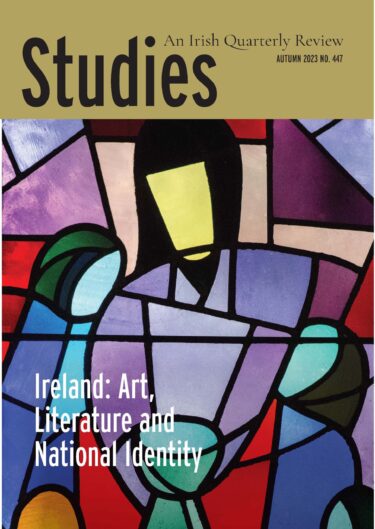Showing all 10 results
The emergence in recent decades of what Jürgen Habermas calls a ‘cosmopolitan Europe’ has certainly helped to dissipate the more aggressive energies of the older order of fully sovereign nation-states, but it has not erased the sense of national consciousness in each of the states within it. We still speak meaningfully of the art or literature of France or Italy or Ireland, and we understand it to mean that nationality, to some extent at least, has a shaping role in artistic composition. There need be nothing hubristic or xenophobic about this. Recognising a kind of ‘national character’ or Volksgeist, to use the language of Johann Gottfried Herder, the eighteenth-century critic of the Enlightenment, may simply be about esteeming cultural diversity and acknowledging that the language, the collective historical memory, the received habits of mind, and even the landscape of a country may have a bearing on the native imagination and give its aesthetic productions an exceptional character. In other words, it can be thought of in cultural rather than political terms.
Which is not to say, of course, that it is not problematic. The cultural can quickly become political. The nineteenth-century Romantic spiritual descendants of Herder drifted with unnerving ease into ethnocentrism, nationalist exceptionalism, and racism. Habermas, who has frequently addressed the knotty issue of cultural diversity, notes that historically European nation-states ‘set themselves apart from one another polemically’. Cultural difference degenerated into a destructive nationalism; and since 1945 Europeans have had to learn ‘the painful lessons of how differences can be communicated, oppositions institutionalized, and tensions stabilized’. Habermas’s hope for the European project lies in his belief that ‘the recognition of differences, the mutual recognition of others in their otherness, can also become a distinguishing mark of a shared identity’.
No doubt Ireland’s colonial experience intensified the native sense of the ‘national character’. In his 1997 book Strange Country, Seamus Deane noted Ireland’s historical refusal to ‘surrender its particularities’, viewing the absorption of Irishness into some larger transnational or universal entity as ‘an impoverishing process that eliminates traditional practices and customs … that are vital to the preservation of the native community’s distinctiveness’. What must be remembered, however, is that distinctiveness does not imply isolatedness. Irish culture has always been interconnected in many ways with many other cultures – has always gained its distinctiveness from the specific ways it has received, responded to, and contributed to the greater human enterprise of imagining and articulating the experience of human existence. Cultural interconnectedness is not merely a product of late modern globalisation.
Consider Ireland’s illuminated gospel manuscripts from the early middle ages – the books of Durrow and Kells, for example. In many respects they appear as quintessentially Irish, yet the interplay of cultures in these works is complex. They merge pre-Christian Celtic art – itself already indebted to earlier La Tène traditions – with artistic elements from the Picts, the Anglo-Saxons, and the Celtic Britons, as well as from Gaul, Italy and the eastern Mediterranean. As historian Jennifer O’Reilly summarises, these features were not slavishly copied in the Irish scriptoria, but ‘quite transformed and exuberantly assimilated into the Insular repertoire and idiom’.3 She notes the paradox that the Celtic art of these manuscripts was ‘energised and … brought to its greatest period of creativity and originality by cross-fertilization with other traditions, both from neighbouring regions and from the Mediterranean world’. There is probably no period of Irish art and literature about which this could not also be said.
***
The web of indebtedness into which Irish art and literature is woven extends over many centuries just as it does over many lands. In T. S. Eliot’s famous essay on ‘Tradition and the Individual Talent’ he asserts that for a poet to enter into the tradition they must acquire what he calls ‘the historical sense’. It ‘involves a perception’, he says, ‘not only of the pastness of the past, but of its presence; the historical sense compels a man to write not merely with his own generation in his bones, but with a feeling that the whole of the literature of Europe from Homer and within it the whole of the literature of his country has a simultaneous existence and composes a simultaneous order’. By this measure (excessively conservative though it may be), James Harpur’s poetry is deeply ensconced in the tradition. In ‘Imagining Kells: A Poetic Meditation on the Book of Kells’, he brings us through his creative process as he penned ‘Kells’, the centrepiece of his 2018 book of poetry, The White Silhouette. The poem brings together four distinct voices in relation to the composition of the book. Two of these voices belong to its creators, an illuminator (‘Goldsmith’) and a scribe; and then we have two witnesses, the twelfth-century priest and historian Gerald of Wales and the poet himself in the twenty-first century. Writing, reading, responding, meditating, all come together and achieve a unity of tradition and contemporaneity.
In ‘The Royal Hibernian Academy of Arts: 200 Years of Social and Artistic Change’, John Turpin recounts the chequered history of the RHA on the occasion of its bicentenary. The purpose of the RHA, like that of the Royal Academy in London, was to foster the development of art in the country, cultivating public art education, attracting patronage, and exhibiting artworks. What is apparent is that Irish artists associated with the RHA tended to look abroad for their stylistic guides: touring Italy for a general artistic education, emulating English portraiture or French landscapes, or taking up avant garde or modernist notions. But the development of an Irish-Ireland ideology gave rise to an anxiety about ‘official’ Irish art especially after the foundation of the state. Should Irish art not define national identity? This question has lost its relevance in more recent times, especially thanks to the globalisation of art.
Declan O’Keeffe, in ‘Frances Biggs and the Windows of Gonzaga College, Dublin’, examines the life and work of Frances Biggs, one of the many great stained glass artists that twentieth-century Ireland produced. Biggs was primarily a musician, playing in the RTÉ symphony orchestra for forty years, but for her, music and colours were always intimately related. The sounds of musical instruments appeared to her mind as colours – synesthesia, this is called. Her stained glass windows in the chapel of Gonzaga College, Dublin, where her husband, Michael Biggs, was commissioned to do the sculpture, displays her heightened sense of colour. A detail from her ‘Last Supper’ window is on the cover of this issue of Studies.
The complexities of Irish national identity are apparent in David Clare’s ‘Maria Edgeworth: Distinguishing the Irish Anglican Ascendancy from the English’. ‘In Irish theatre and film,’ Clare notes, ‘there is a long history of getting English actors to play Irish Anglican parts, without getting them to adopt even a hint of Irishness in their embodying of the parts.’ But Maria Edgeworth’s novels convey a very different sense of the members of the Anglican Ascendancy. In her work they are decisively Irish, as distinct in their vices and their virtues from the English people of their time as the Irish
Gaelic Catholics were. And for the most part, Edgeworth, herself a member of the Ascendancy, tended to portray the members of her class as ‘inescapably Irish’ but, just like all Irish people, capable of being ‘improved’ by being ‘exposed to enlightened ideas from other places, such as England, France, Switzerland, or Italy’.
Seamus Heaney, who died ten years ago this August, spoke on various occasions about the problematic nature of his Northern identity. His passport may have been green, but he stood opposed to bigotry, to what he called ‘the furious characterisations of the Unionist, Protestant collective in the North’. In ‘Seamus Heaney and Education: Student and Teacher’, Bríd McGuinness does not deal directly with this tension in Heaney’s sense of his identity, but she discusses the fact that he was ‘constantly aware of dualities throughout his life’. Central in his psyche as a poet is the sense of being ‘in between’ and of attaining balance. And in his literary education, what dominated was openness to the world beyond the North, beyond the island of Ireland. McGuinness quotes Heaney’s address to the Swedish Academy: by encountering ‘the gutturals and sibilants of European speech’ as he listened to the family wireless as a child, ‘I had already begun a journey into the wideness of the world’.
***
Ireland’s Decade of Centenaries draws to a close. One last political event that merits commemoration is the 1923 General Election, which marked the nervous beginning of normal politics in the new state, just four months after the end of the Civil War. In ‘The Dáil General Election of August 1923’, Anthony White maps out the issues and the outcomes of this election. He identifies a number of reasons for its considerable importance, not the least of which is the fact that partition did not figure as a major issue even though the civil war, which formed the background to the election, was precisely fought over the question of the North-South border.
Séamus Murphy SJ’s ‘Confronting the Past for the Sake of the Future’ also considers Ireland’s fraught legacy of political difference and violence. Ireland’s past, he argues, quoting Hannah Arendt, needs not only to be understood but to be confronted. In particular, he insists that commemorations of the events of 1912–1923 failed to revise interpretations of Irish history, as they ought to have done, in line with the endorsed principles of the 1998 Good Friday Agreement.
Fiachra Long, in ‘Gnostic Currents in Our Avatar Culture’, addresses the timely and critical question of how we ought to respond to the threat that Artificial Intelligence ‘might push an increasing number of situations beyond the scope of human judgement’. Are there certain choices that should be reserved to humans? And what in particular should we make of ‘conversational avatars’, imaginary personae that mimic human beings down to the last detail? Long detects the presence of a deep Gnosticism in such a separation of the human mind and body, a seductive promise of being freed from materiality and encounter.
In ‘Cardinal Owen McCann, Angola and Mozambique: Greater Ireland Meets Greater Portugal’, Alexandra Maclennan presents the story of South Africa’s first cardinal, the second-generation Irishman, Owen McCann. She traces his progress in the ecclesiastical world and pays close attention to his initial fascination with the Christian corporatism of Portugal’s long-standing conservative Catholic prime minister, António de Oliveira Salazar. McCann did eventually turn away from ‘the shadows of Salazar’s failed corporative utopia’ and began to espouse, not liberation theology, but a Christian anthropology that opposed injustice in southern African countries, especially in the context of Portuguese decolonisation.
In ‘The Enduring Relevance of Catholic Social Teaching’, a review article of two books on Catholic social teaching, Mark Bell recommends them both unreservedly. Anna Rowland’s Towards a Politics of Communion: Catholic Social Teaching in Dark Times provides a deep and up-to-date perspective on the broad field of CST. She stresses the foundational principles of human dignity, communion, and the universal destination of the goods of the earth, and she echoes Pope Francis’s strenuous opposition to globalised capitalism and other forces that fail to show solidarity with migrants and other marginalised persons. Anthony Annett’s Cathonomics: How Catholic Tradition Can Create a More Just Economy tackles a narrower field, how CST can be applied to the world’s most pressing economic problems, such as global inequality and environmental sustainability, and he does so thoroughly. Both works, Bell says, are to be commended for being, ultimately, ‘underpinned by hope’. Catholic Social Teaching, both authors hold, can indeed help in navigating a path out of dark times.
I would like to thank Digital Collections of the Library of Trinity College Dublin for their work in providing us with the images of three folios from the Book of Kells and their kind permission to publish them in this issue.

